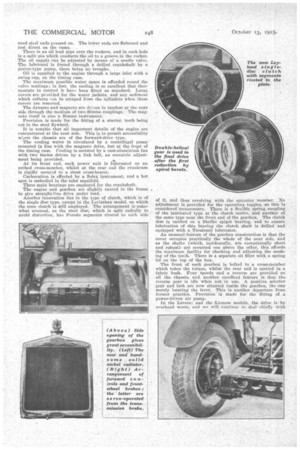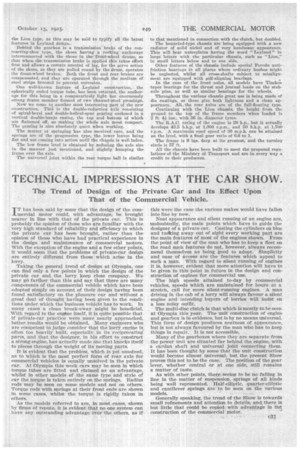LEYLAND PASSENGER VEHICLE PLANS.
Page 13

Page 14

Page 15

If you've noticed an error in this article please click here to report it so we can fix it.
The Latest Products of Leyland Motors, Ltd., Embodying Overhead Valve Engines, Accessible Gearboxes, Front-wheel Brakes and Silent Doublereduction Axles.
TEE commercial vehicles produced at the works of Leyland Xtotors, Ltd., have for many years maintained an enviable position in the commercial vehicle markets of the world. This has been due to their excellent design, robustness of construction, and the employment of the finest materials, but even such well-known makers as are this company freely admit that, until 'now, the majority of passenger vehicle models have been more in the nature of converted goods chassis than otherwise, and they point out that with the low-speed vehicles running on solid tyres, which were formerly employed, it would probably have been unwise to have provided anything different. Now, however, the increasing employment of pneumatic tyres, higher speeds and bodies of greater capacity necessitate a completely new study of the problem and tho throwing overboard of practically all old ideas.
Following this principle, after 18 months designing and testing, and without rushing blindly into the production of new chassis, they have developed an entirely new line of passenger models ranging from the 20-seater up to the52seater double-decker with covered top. Actual production on a commercial basis will commence towards the end of November. The present models from which the illustrations have been made were built by the experimental department, but an enormous number of jigs and other special tools have been ordered for quantity production.
Chassis for goods vehicles will, of course, not be neglected, but no changes other than normal development will be made in these for a .ong time.
The new chassis are five in number. They comprise the Leveret, which is a fast, small chassis of the bonneted type for 20-seaters; the Lioness. a 26-seater bonneted type ; the Lion, a 31-seater, forward-drive model; the Leopard, a similar model for 38-seaters ; and the Leviathan, a model suitable for 52-seater double-deck buses.
The question of lowering the frame level on these chassis was carefully gone into, and the makers decided to carry this out to what they consider a commercially practicable extent, paying due regard to the important factor of accessibility, and not-to go to extremes.
Front-wheel brakes can be supplied on all models above the 20-seater, ..•uch brakes being servo-operated from the transmission brakes, whilst the side brakes act on separate brake shoes in the rear wheels.
An outstanding departure lies in the design of the power units ; these all have overhead valves operated, through the medium of rockers and long tappets, from a camshaft in the cnnkcase. The power units covering the range of chassis all have four cylinders cast in pairs and with detachable heads. The smallest, used on the Leveret and the Lioness, has a bore and stroke of 31 ins, and 51 ins. respectively ; next comes the 41 ins. by 5i ins, unit of the Lion, in which the same base is employed ; whilst the dirhensions of the remaining two for the Leopard and Leviathan respectively arc 41 ins. by 61 ins. and 5 ins. by 61 ins., both on the same crankcase., which is larger than that employed on the first two mentioned.
No valve caps are employed, it being found easier and quicker to detarth the heads than to remove such caps, and lever lifts are left at the corners to enable this to be done without injuring the gaskets. The valves, have double springs and the rocker arms are mounted in pairs on tubes carried by a pillar. Each arm has a split end holding, by means of a locking bolt, a spherically ended screw resting in a cup at the top of its tappet. The tappets are tubular, with hard ened steel ends pressed on. The lower ends are flattened and rest direct on the cams. ,
There is an oil lead pipe over the rockers, and in each hole is a split pin which conducts the oil to a groove in the rocker. The oil supply can be adjusted by means of a needle valve. The lubricant is forced through a drilled crankshaft by a pinion-type pump, there being no troughs. Oil is supplied to the engine through a large inlet with a swing cap, on the timing case. The maximum possible water Space is afforded round the valve seatings; in fact, the cooling is so excellent that thermostats to control it have been fitted as standard. Large covers are provided for the water jackets, and any sediment which collects ean be scraped from the cylinders when those covers are removed.
The dynamo and magneto are driven in tandem at the near side through the medium of two Simms couplings. The magneto itself is also a Simms instrument.
Provision is made for the fitting of a starter, teeth being cut in the steel flywheel. It is notable that all important details of the engine are concentrated at the near side. This is to permit accessibility w...ere the chassis are of the forward-drive type. The cooling water is circulated by a centrifugal pump mounted in line with the magneto drive, but at the fropt of the timing case. Cooling is assisted by a cast-aluminium fan with two blades driven by a link belt, an eccentric adjust ment being provided. 4 At its front end, each power unit is fulcrumed on an arched•eroas-member, whilst at the rear end the crankcase is rigidly secured to a stout cross-bearer.
. Carburation is effected by a Sokx instrument, and a hot spot is embodied in the inlet manifold.
Three main bearings are employed for the crankshaft. The engine and gearbox are slightly canted in the frame to give straight-line drive under load. Another innovation lies in the type of clutch, which is of the single disc type, except in the Leviathan model, on which the cone clutch is still employed. The arrangement is somewhat unusual, as the steel disc, which is split radially to avoid distortion, has Ferodo segments riveted to CESch side of it, and thus reVolving with the spinning member. No adjustment is provided for the operating toggles, as this is considered unnecessary. There is a flexible spring coupling of the laminated type at the clutch centre, and another of the same type near the front end of the gearbox. The clutch disc is carried on a Skefko spigot hearing, and to ensure lubrication of this bearing the clutch shaft is drilled and equipped with a. Tecalemit lubricator. An unusual feature of the 'gearbox construction is that the cover occupies Practically the whole of the near side, and as the shafts (which, incidentally, are exceptionally short and robust) are mounted one above the other, this affords the maximum facility for checking and adjusting the meshing of the tee:h. There is a separate oil filler with a spring lid on the top of the box. The front of each gearbox is bolted to a cross-member which takes the torque, whilst the rear end is carried in a fabric bush. Four speeds and a reverse are provided on all the chassis, and another excellent feature is that the. reverse gear is idle when not in use. A positive selector gear and lock are now situated inside the gearbox, the 'cap merely locating the lever. This is another departure from former practice. Provision is made for the fitting of a Power-driven air pump.
In the Levere: and the Lioness models, the drive is by overhead worm,and we will continue to deal chiefly with
the Linn type, as this may be said to typify all the latest features in Leyland design.
Behind the gearbox is a transmission brake of the contracting-shoe type, the shoes having a rocking anchorage interconnected with the shoes in the trait-wheel drums, so that when the transmission brake is applied this takes effect iirst and allows a certain amount of lag, for the servo action of the shoes, as they are pulled round by the drum, operates the front-wheel brakes. Both the front and rear brakes are compensated, and they are operated through the medium of steel strips bronzed to prevent corrosion. One well-known feature of Leyland construction, the spherically ended torque tube, has been retained, the anchorage for this being in a comparatively light but enormously strong frame member formed of two channel-steel preSsings.
Now we come to another most interesting part of the new construction. This is the double-reduction axle consisting of spiral-bevel and double-helical-spur gearing enclosed in a vertical double-banjo casing, the top and-bottom of which are flattened off, so making the whole axle most compact. The gearing is also absolutely quiet when working.
The matter of springing has also received care, and the springs are of the :progressive type, the lower leaves being fiat and notcoming int3 action until the chassis is well laden.
The low frame level is obtained by reducing the axle size in the manner just mentioned, and slightly humping the frame over the axle.
The universal joint within the rear torque ball is similar to that mentioned in connection with the clutch, but doubled.
The bonneted-type chassis are being equipped with a new radiator of solid nickel and of very handsome appearance. This will bear nameplates having the word "Leyland" in large letters with the particular chassis, such as "Lion," in small letters below and to one side.
Other features of the chassis include special Ferodo antifriction bearings in all places where ordinary bushes might be neglected, whilst all cross-shafts subject to misalignment are equipped with self-aligning bearings.
In the case of the front axles, all models have Timken taper bearings for the thrust and journal loads on the stubaxle pins, as well as similar bearings for the wheels.
Throughout the various chassis great use is being made of die castings, as these give both lightness and a clean appearance. All the rear axles are of the full-floating type.
Continuing with the Lion chassis, the height from the ground to the top of the frame members when loaded is 2 ft. 4i ins., with 36 in. diameter tyres.
The R.A.C. rating of the engine is 29 h.p., but it actually develops 43.5 b.h.p. at 1,000 r.p.m„ and 50 b.h.p. at 1,700 r.p.m. A maximum road speed of 36 m.p.h. can be attained on the level, with a final gear ratio of 6.6 to I.
The frame is 9 ills. deep at its greatest, and the turning circle is 57 ft.
All the chassis have been built to meet the proposed regulations of the Ministry of Transport and fire in every way a credit to their producers.






























